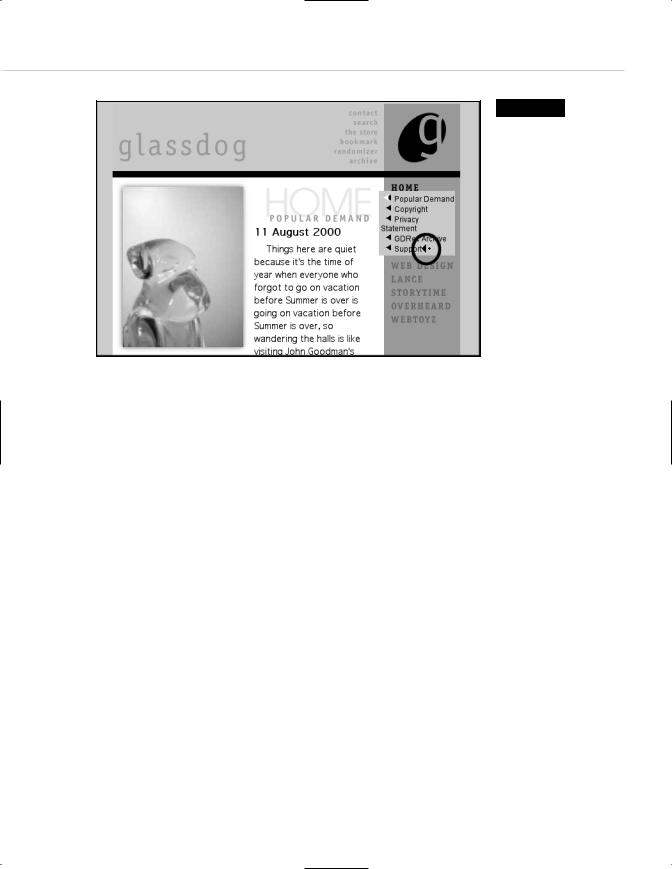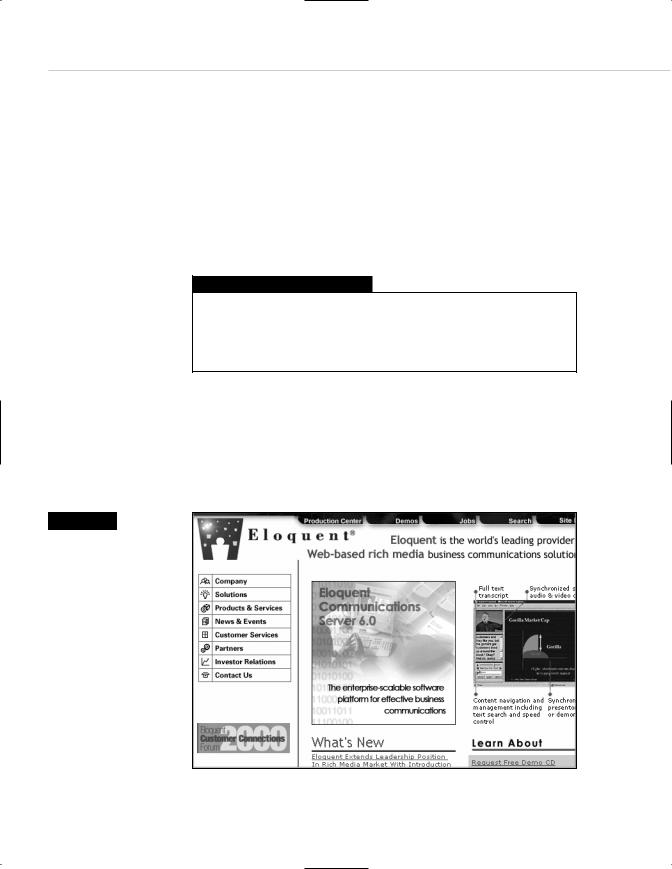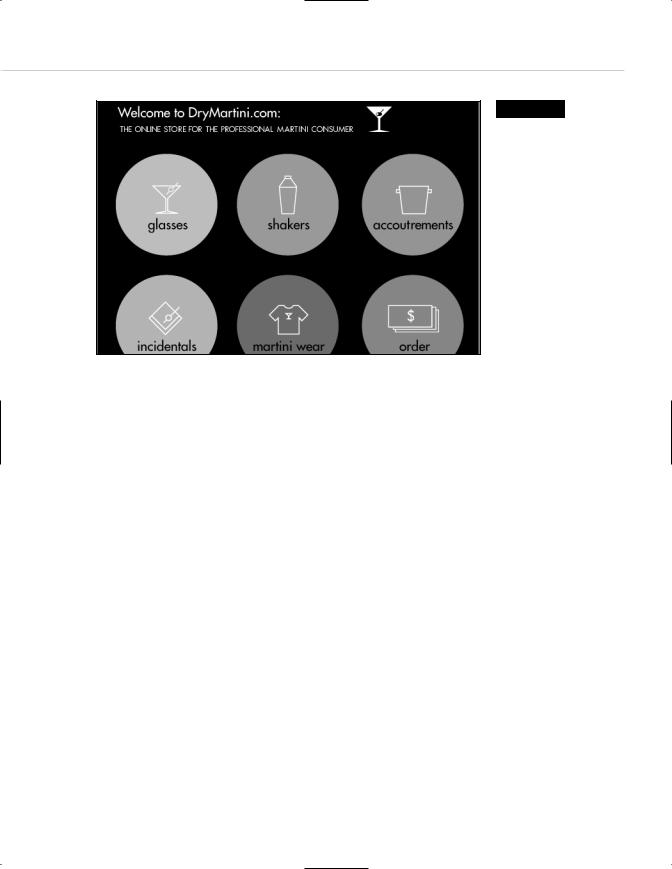
- •Taking Your Talent to the Web
- •Introduction
- •1 Splash Screen
- •Meet the Medium
- •Expanding Horizons
- •Working the Net…Without a Net
- •Smash Your Altars
- •Breath Mint? Or Candy Mint?
- •Where’s the Map?
- •Mars and Venus
- •Web Physics: Action and Interaction
- •Different Purposes, Different Methodologies
- •Web Agnosticism
- •Point #1: The Web Is Platform-Agnostic
- •Point #2: The Web Is Device-Independent
- •The 18-Month Pregnancy
- •Chocolatey Web Goodness
- •’Tis a Gift to Be Simple
- •Democracy, What a Concept
- •Instant Karma
- •The Whole World in Your Hands
- •Just Do It: The Web as Human Activity
- •The Viewer Rules
- •Multimedia: All Talking! All Dancing!
- •The Server Knows
- •It’s the Bandwidth, Stupid
- •Web Pages Have No Secrets
- •The Web Is for Everyone!
- •Swap text and code for images
- •Prune redundancy
- •Cache as Cache Can
- •Much Ado About 5K
- •Screening Room
- •Liquid Design
- •Color My Web
- •Thousands Weep
- •Gamma Gamma Hey!
- •Typography
- •The 97% Solution
- •Points of Distinction
- •Year 2000—Browsers to the Rescue
- •Touch Factor
- •Appropriate Graphic Design
- •User Knowledge
- •What Color Is Your Concept?
- •Business as (Cruel and) Usual
- •The Rise of the Interface Department
- •Form and Function
- •Copycats and Pseudo-Scientists
- •Chaos and Clarity
- •A Design Koan: Interfaces Are a Means too Often Mistaken for an End
- •Universal Body Copy and Other Fictions
- •Interface as Architecture
- •Ten (Okay, Three) Points of Light
- •Be Easily Learned
- •Remain Consistent
- •Continually Provide Feedback
- •GUI, GUI, Chewy, Chewy
- •It’s the Browser, Stupid
- •Clarity Begins at Home (Page)
- •I Think Icon, I Think Icon
- •Structural Labels: Folding the Director’s Chair
- •The Soul of Brevity
- •Hypertext or Hapless Text
- •Scrolling and Clicking Along
- •Stock Options (Providing Alternatives)
- •The So-Called Rule of Five
- •Highlights and Breadcrumbs
- •Consistent Placement
- •Brand That Sucker!
- •Why We Mentioned These Things
- •The year web standards broke, 1
- •The year web standards broke, 2
- •The year web standards broke, 3
- •The year the bubble burst
- •5 The Obligatory Glossary
- •Web Lingo
- •Extranet
- •HTML
- •Hypertext, hyperlinks, and links
- •Internet
- •Intranet
- •JavaScript, ECMAScript, CSS, XML, XHTML, DOM
- •Web page
- •Website
- •Additional terminology
- •Web developer/programmer
- •Project manager
- •Systems administrator (sysadmin) and network administrator (netadmin)
- •Web technician
- •Your Role in the Web
- •Look and feel
- •Business-to-business
- •Business-to-consumer
- •Solve Communication Problems
- •Brand identity
- •Restrictions of the Medium
- •Technology
- •Works with team members
- •Visually and emotionally engaging
- •Easy to navigate
- •Compatible with visitors’ needs
- •Accessible to a wide variety of web browsers and other devices
- •Can You Handle It?
- •What Is the Life Cycle?
- •Why Have a Method?
- •We Never Forget a Phase
- •Analysis (or “Talking to the Client”)
- •The early phase
- •Design
- •Brainstorm and problem solve
- •Translate needs into solutions
- •Sell ideas to the client
- •Identify color comps
- •Create color comps/proof of concept
- •Present color comps and proof of concept
- •Receive design approval
- •Development
- •Create all color comps
- •Communicate functionality
- •Work with templates
- •Design for easy maintenance
- •Testing
- •Deployment
- •The updating game
- •Create and provide documentation and style guides
- •Provide client training
- •Learn about your client’s methods
- •Work the Process
- •Code Wars
- •Table Talk
- •XHTML Marks the Spot
- •Minding Your <p>’s and q’s
- •Looking Ahead
- •Getting Started
- •View Source
- •A Netscape Bonus
- •The Mother of All View Source Tricks
- •Doin’ it in Netscape
- •Doin’ it in Internet Explorer
- •Absolutely Speaking, It’s All Relative
- •What Is Good Markup?
- •What Is Sensible Markup?
- •HTML as a Design Tool
- •The Frames of Hazard
- •Please Frame Safely
- •Framing Your Art
- •<META> <META> Hiney Ho!
- •Search Me
- •Take a (Re)Load Off
- •WYSIWYG, My Aunt Moira’s Left Foot
- •Code of Dishonor
- •WYS Is Not Necessarily WYG
- •Publish That Sucker!
- •HTMHell
- •9 Visual Tools
- •Photoshop Basics: An Overview
- •Comp Preparation
- •Dealing with Color Palettes
- •Exporting to Web-Friendly Formats
- •Gamma Compensation
- •Preparing Typography
- •Slicing and Dicing
- •Rollovers (Image Swapping)
- •GIF Animation
- •Create Seamless Background Patterns (Tiles)
- •Color My Web: Romancing the Cube
- •Dither Me This
- •Death of the Web-Safe Color Palette?
- •A Hex on Both Your Houses
- •Was Blind, but Now I See
- •From Theory to Practice
- •Format This: GIFs, JPEGs, and Such
- •Loves logos, typography, and long walks in the woods
- •GIFs in Photoshop
- •JPEG, the Other White Meat
- •Optimizing GIFs and JPEGs
- •Expanding on Compression
- •Make your JPEGS smaller
- •Combining sharp and blurry
- •Animated GIFs
- •Creating Animations in ImageReady
- •Typography
- •The ABCs of Web Type
- •Anti-Aliasing
- •Specifying Anti-Aliasing for Type
- •General tips
- •General Hints on Type
- •The Sans of Time
- •Space Patrol
- •Lest We Fail to Repeat Ourselves
- •Accessibility, Thy Name Is Text
- •Slicing and Dicing
- •Thinking Semantically
- •Tag Soup and Crackers
- •CSS to the Rescue…Sort of
- •Separation of Style from Content
- •CSS Advantages: Short Term
- •CSS Advantages: Long Term
- •Compatibility Problems: An Overview
- •Working with Style Sheets
- •Types of Style Sheets
- •External style sheets
- •Embedding a style sheet
- •Adding styles inline
- •Fear of Style Sheets: CSS and Layout
- •Fear of Style Sheets: CSS and Typography
- •Promise and performance
- •Font Size Challenges
- •Points of contention
- •Point of no return: browsers of the year 2000
- •Absolute size keywords
- •Relative keywords
- •Length units
- •Percentage units
- •Looking Forward
- •11 The Joy of JavaScript
- •What Is This Thing Called JavaScript?
- •The Web Before JavaScript
- •JavaScript, Yesterday and Today
- •Sounds Great, but I’m an Artist. Do I Really Have to Learn This Stuff?
- •Educating Rita About JavaScript
- •Don’t Panic!
- •JavaScript Basics for Web Designers
- •The Dreaded Text Rollover
- •The Event Handler Horizon
- •Status Quo
- •A Cautionary Note
- •Kids, Try This at Home
- •The Not-So-Fine Print
- •The Ever-Popular Image Rollover
- •A Rollover Script from Project Cool
- •Windows on the World
- •Get Your <HEAD> Together
- •Avoiding the Heartbreak of Linkitis
- •Browser Compensation
- •JavaScript to the Rescue!
- •Location, location, location
- •Watching the Detection
- •Going Global with JavaScript
- •Learning More
- •12 Beyond Text/Pictures
- •You Can Never Be Too Rich Media
- •Server-Side Stuff
- •Where were you in ‘82?
- •Indiana Jones and the template of doom
- •Serving the project
- •Doing More
- •Mini-Case Study: Waferbaby.com
- •Any Size Kid Can Play
- •Take a Walk on the Server Side
- •Are You Being Served?
- •Advantages of SSI
- •Disadvantages of SSI
- •Cookin’ with Java
- •Ghost in the Virtual Machine
- •Java Woes
- •Java Woes: The Politically Correct Version
- •Java Joys
- •Rich Media: Exploding the “Page”
- •Virtual Reality Modeling Language (VRML)
- •SVG and SMIL
- •SMIL (through your fear and sorrow)
- •Romancing the logo
- •Sounds dandy, but will it work?
- •Promises, Promises
- •Turn on, Tune in, Plug-in
- •A Hideous Breach of Reality
- •The ubiquity of plug-ins
- •The Impossible Lightness of Plug-ins
- •Plug-ins Most Likely to Succeed
- •Making It Work: Providing Options
- •The “Automagic Redirect”
- •The iron-plated sound console from Hell
- •The Trouble with Plug-ins
- •If Plug-ins Run Free
- •Parting Sermon
- •13 Never Can Say Goodbye
- •Separation Anxiety
- •A List Apart
- •Astounding Websites
- •The Babble List
- •Dreamless
- •Evolt
- •Redcricket
- •Webdesign-l
- •When All Else Fails
- •Design, Programming, Content
- •The Big Kahunas
- •Beauty and Inspiration
- •Index

Taking Your Talent to the Web |
87 |
Figure 3.10
So why confuse them with this one? Changing familiar GUI elements “because you can” is a dog’s rationale for licking himself. In this case, it’s a Glassdog’s rationale (www.glassdog.com).
CLARITY BEGINS AT HOME (PAGE)
In developing GUI elements, web designers will frequently begin with the brand: funky elements for an entertainment site pitched at 20-somethings; somber, restrained elements for a news or medical site; and so on (more about branding in a moment). As each site presents a visitor with new GUI elements, those elements have the potential to brand the site while offering visitors a sense of identity and place. These elements also have the potential to confuse the heck out of people. As with the operating systems they mimic, GUI elements should be as clear and easy to use as possible. Clarity and ease of use are especially crucial factors in the development of iconic interface elements and site structure labels.

88 WHY: Where Am I? Navigation & Interface: Clarity Begins at Home (Page)
I Think Icon, I Think Icon
Graphical devices (icons) guide viewers through the site experience. Forward and reverse arrows are common ways of navigating from page to page. Graphical buttons are often used to trigger certain actions. For instance, a Play button may be used to trigger a recorded sound or an embedded, streaming QuickTime movie. A pen or pencil icon may link to a message board, or a book or newspaper icon can guide the visitor to a downloadable, printer-friendly version of the page’s content.
Printing in the Browser Wars
Why aren’t web pages themselves printer-friendly? It is because too often browsers are rushed into production as the latest assault in the “Browser Wars,” instead of offering carefully considered and usable features. By the time this book is released, the worst of the Browser Wars will be behind us.
Icons, with or without text labels, frequently serve as quick, visual cues to the site’s offerings. They also support international visitors for whom English is not a first language. Sites with massive amounts of content on their home pages, such as portals and magazine sites, can use icons to better organize and clarify sections (see Figures 3.11 and 3.12).
Figure 3.11
The icons seen here help draw the eye to the secondary menu, and some of them even communicate in ways a non-English speaking visitor might understand. Designing icons that communicate is difficult. Competing elements must fit within the narrow width of a lowest- common-denominator monitor, leaving little room in which to develop legible imagery (www.eloquent.com).

Taking Your Talent to the Web |
89 |
Figure 3.12
We are clearly in the land of the recreational website, as denoted by the tagline “professional martini consumer.” Few sites would devote all that screen space to a menu structure. Indeed, this site recently went offline for a redesign (www.drymartini.com).
On the Web, as in talking to a policeman, clarity is a virtue. While it is tempting to get really creative with such elements, the most creative solutions are often the clearest.
Say you are designing a site for a chain of Wild West theme hotels. In visiting the hotels and studying the chain’s promotional brochures and advertising, you can’t miss the fact that Western paraphernalia is used to brand the franchise—from the bronze horse-head coat hooks in guest closets to the cowhide couches in the lobby. Thinking like a brand steward, you decide it might be fun to use lassos rather than arrows to indicate “previous page” and “next page” on the site. To you, as a visual person, it is readily apparent that the rope at the edge of the lasso “points” forward or backward.
Well, cowboy, test that design on some users before you fight for it. If users are confused by your branded iconic elements—if the lassos strike users as meaningless ornamentation rather than functional GUI elements—be prepared to rustle up some traditional left and right arrows, even if it chaps your spurs.

90 WHY: Where Am I? Navigation & Interface: Clarity Begins at Home (Page)
Adding “invisible” text labels to an icon via the <ALT> attribute of the HTML image tag or the <TITLE> attribute of a linked image can help explain the icon’s purpose to inexperienced users. In modern graphical browsers, these <ALT> and <TITLE> attributes generate popup “tool tips” or help-bal- loon-style blurbs, enhancing the page’s interactivity in a meaningful and user-friendly way.
Such tags also make the content more accessible to the visually disabled, to those using non-graphical browsers or Personal Digital Assistants (PDAs) such as the Palm Pilot, and to folks using conventional browsers who surf with images turned off. (As mentioned in Chapter 2, accessibility makes good business and moral sense. Besides, it’s U.S. law.)
When invisible text labels are not enough, consider adding visible text.
Structural Labels: Folding the Director’s Chair
In the early days of the Web, designers and copywriters frequently had fun coming up with creative labels for menu bar sections and other navigational items. For instance, the home page of a video editing company’s site might be labeled “The Director’s Chair,” while downloadable video clips would be found in “The Screening Room.”
Today, most web agencies find it better to err on the side of clear copy than cute copy. After all, if the visitor does not immediately grasp what “The Screening Room” means, she could leave the site without having discovered one of its most important content areas. While alternatives to traditional labeling may be appropriate for some types of sites (gaming sites, fun sites for kids), many corporate sites depend on such traditional labels as Home, About, and Clients to facilitate easy user navigation. Dull as dishwater, we know. Be creative clearly, and it need not be dull at all.
The Soul of Brevity
Back in Chapter 2 we recalled David Siegel’s three hallmarks of good website design:
■Clarity
■Brevity
■Bandwidth
